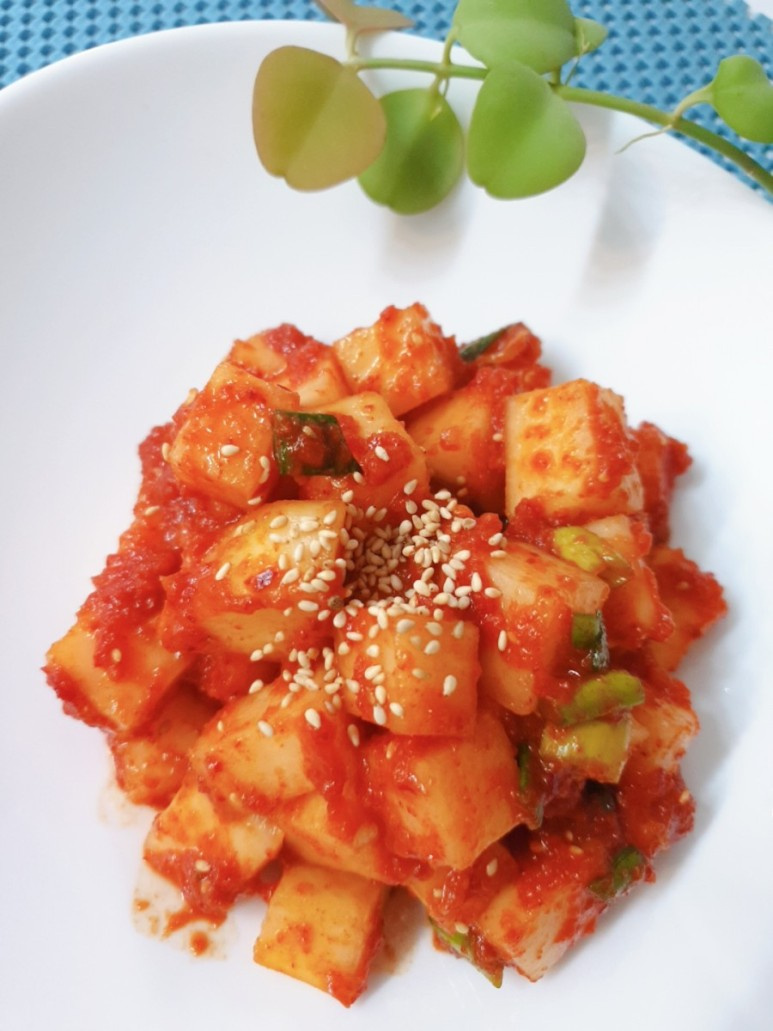Quick & Easy 30-Minute Radish Kimchi (Kkakdugi)
A Speedy Recipe for Delicious Kkakdugi in Just 30 Minutes

Craving some Soon-dae Guk (Korean blood sausage soup)? Let’s whip up some simple Kkakdugi to go with it! This recipe is perfect for when you need a quick, fresh, and crunchy side dish.
Salting the Radish- 1 Korean radish (medium size)
- 2 Tbsp coarse sea salt
- 1 Tbsp sugar
Blended Seasoning Ingredients- 2 Tbsp minced garlic
- 1 small knob of ginger
- 5 red chili peppers
- 1 Tbsp fish sauce
- 2 Tbsp plum extract (maesilcheong)
Mixing Seasoning Ingredients- 4 Tbsp red chili powder (gochugaru)
- 3 Tbsp glutinous rice paste (chapssalpul)
- 1/2 Tbsp salt (adjust to taste)
- A little green onion (chopped)
Making the Glutinous Rice Paste- 1/2 paper cup water (approx. 100ml)
- 1/2 Tbsp glutinous rice flour
- 2 Tbsp minced garlic
- 1 small knob of ginger
- 5 red chili peppers
- 1 Tbsp fish sauce
- 2 Tbsp plum extract (maesilcheong)
Mixing Seasoning Ingredients- 4 Tbsp red chili powder (gochugaru)
- 3 Tbsp glutinous rice paste (chapssalpul)
- 1/2 Tbsp salt (adjust to taste)
- A little green onion (chopped)
Making the Glutinous Rice Paste- 1/2 paper cup water (approx. 100ml)
- 1/2 Tbsp glutinous rice flour
- 1/2 paper cup water (approx. 100ml)
- 1/2 Tbsp glutinous rice flour
Cooking Instructions
Step 1
First, wash the Korean radish thoroughly and cut it into bite-sized cubes, about 1.5 to 2 cm. In a bowl, combine the cubed radish with 2 tablespoons of coarse sea salt and 1 tablespoon of sugar. Mix well and let it sit for 15 minutes to salt. While the radish is salting, we’ll quickly make the glutinous rice paste. In a small pot, whisk together 1/2 paper cup of water and 1/2 tablespoon of glutinous rice flour until smooth. Cook over low heat, stirring constantly, until it thickens into a paste. Let the rice paste cool down completely.

Step 2
Now, let’s prepare the blended seasoning for the Kkakdugi. In a blender, combine 2 tablespoons of minced garlic, 1 small knob of ginger, and 5 red chili peppers (cut into manageable pieces). Add 1 tablespoon of fish sauce and 2 tablespoons of plum extract. Blend until smooth. (Tip: For a cleaner and spicier flavor, you can add 1-2 Korean green chilies. Adding 1/4 pear or 1/4 onion to the blender will enhance the savory taste.)

Step 3
After 15 minutes of salting, the radish will have released quite a bit of water. Drain the radish using a colander, keeping the salted water separate for now. Crucially, do not rinse the salted radish! Rinsing will wash away the saltiness and umami, preventing the Kkakdugi from developing its characteristic flavor.

Step 4
It’s time to mix everything together! In a large bowl, combine the blended seasoning mixture with 3 tablespoons of the cooled glutinous rice paste and the chopped green onions. Mix these seasoning ingredients well first. Once the seasoning is evenly combined, add the drained salted radish to the bowl. Gently mix and toss everything together, ensuring the radish cubes are evenly coated with the seasoning. Be careful not to mash the radish cubes.

Step 5
Finally, taste and adjust the seasoning if needed. Add 1/2 tablespoon of salt if it’s not salty enough, but it’s best to err on the side of slightly less salty, as the flavor will develop further during fermentation. You can sprinkle sesame seeds on top for an extra touch of flavor, or leave them out if you prefer. Transfer the finished Kkakdugi to an airtight container and store it in the refrigerator. It’s delicious to eat right away, but even better after a day or two of fermentation when the flavors have melded beautifully.




